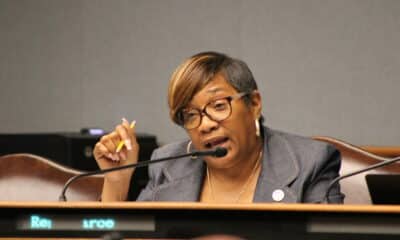Kaiser Health News
Health Worker for a Nonprofit? The New Ban on Noncompete Contracts May Not Help You
Harris Meyer
Wed, 05 Jun 2024 09:00:00 +0000
Many physicians and nurses are happy about the Federal Trade Commission’s new rule banning the use of noncompete agreements in employment contracts. But they are disappointed that it may not protect those who work for nonprofit hospitals and health care facilities, which provide most of the nation’s care and employ the largest number of medical professionals.
In April, in a 3-2 vote, the FTC approved a final rule prohibiting contracts that prevent an employee from taking a job with a competitor. Calling the noncompete agreements “a widespread and often exploitative practice,” an agency announcement described them as an unfair method of competition that depresses wages and hinders new business formation.
The rule bars employers in most industries, including health care, from using contract clauses that block employees from leaving for other jobs or starting a competing business in the same geographic area for a fixed period of time.
But that doesn’t help many health professionals, because the FTC Act gives the agency authority over companies organized to operate for profit but not over nonprofit, charitable organizations, which are also tax-exempt.
Still, the agency noted some nonprofits could be bound by the rule if they do not operate as true charities. The rule establishes a two-part test to determine if the FTC has jurisdiction over a nonprofit — whether the organization is carrying on business for only charitable purposes, and whether its income goes to public rather than private interests.
“Our rulemaking record includes powerful stories from health care workers who are employed by nonprofits about how noncompetes hurt patients and providers,” said FTC Commissioner Rebecca Kelly Slaughter, one of three Democratic commissioners, in comments before the April 23 vote. “I do not think there is a good justification for them to be excluded from this rule.”
Noncompete contract terms have become increasingly common for physicians, nurse practitioners, and other medical professionals in hospitals and various health care facilities. Some providers say these agreements have forced them to leave their communities and patients behind if they wanted to exit unethical or unsafe workplace conditions.
Nearly 64% of U.S. community hospitals are nonprofits or government-owned, and they employ many of the nation’s medical professionals. As of 2022, nearly three-quarters of U.S. physicians were employed by hospital systems or other companies, both nonprofit and for-profit.
Based on their designation as charities that don’t have to pay income or property taxes, U.S. nonprofit hospitals received a total estimated tax exemption of $28 billion in 2020, according to KFF, a nonpartisan research organization.
That exceeded the estimated $16 billion they spent on charity care for patients unable to afford their medical bills, KFF said.
Physician and nursing groups say it makes no sense to treat nonprofit hospitals differently because they are just as money-driven as for-profit hospitals. Patients, they say, will benefit if providers are free to call out unsafe conditions and change jobs. “Giving physicians freedom of movement will force hospitals to compete to improve working conditions,” said Jonathan Jones, immediate past president of the American Academy of Emergency Medicine.
Chad Golder, general counsel and secretary of the American Hospital Association, which represents mostly nonprofit hospitals, said the rule would increase health care costs and reduce patient access by triggering hospital bidding wars for physicians. He predicted the FTC would try to apply the rule to both nonprofit and for-profit hospitals.
“They aren’t saying exactly what they’ll do, but it’s a pretty significant move for them to say we’ll apply our own test to determine if we can regulate a nonprofit,” Golder said. “Nonprofit entities now will need to be extra careful.”
In addition, some nonprofit hospitals have joint ventures with for-profit hospitals and medical groups. That could create complicated questions about whether their employee contracts come under the rule, said Chip Kahn, president and CEO of the Federation of American Hospitals, which represents for-profits.
The new rule arose from President Joe Biden’s 2021 executive order instructing the FTC to curb the unfair use of noncompete agreements, part of his broader mandate to boost U.S. economic competition and worker mobility.
The FTC argued that banning noncompetes, which it said cover 1 in 5 American workers, would lower health care costs by up to $194 billion over the next decade. It will ensure Americans “freedom to pursue a new job, start a new business, or bring a new idea to market,” FTC Chair Lina Khan said.
The rule also prohibits contract terms that function like noncompetes to stop employees from leaving to work for competing companies or start their own businesses. These might include overbroad nondisclosure agreements, training repayment provisions, and nonsolicitation clauses.
“No one should be trapped in an unsafe job by onerous contracts that prevent them from taking another job,” said Brynne O’Neal, a regulatory policy specialist at National Nurses United, the profession’s largest dedicated labor union in the U.S. Hospitals, she said, use training repayment agreement provisions that require nurses to pay as much as $30,000 in training costs if they leave, essentially locking them in their jobs.
California, Minnesota, North Dakota, and Oklahoma already ban enforcement of noncompete clauses for all employees of both nonprofits and for-profits, while about nine other states prohibit noncompetes for physicians. Even in states without bans, judges have invalidated noncompetes when they have found them to be overbroad or unreasonable.
Hospital executives argue that the noncompete rule will force them to compete against each other to hire physicians and other providers and ultimately cost them more, and that it advantages nonprofits over for-profits. “All it would do is increase the price of labor in a field that already has labor shortages and thin margins,” Golder said.
“The nonprofit hospital across the street could pursue our employees, while their employees would be protected, and that’s a basic fairness issue,” Kahn said.
But Clifford Atlas, an employment attorney with Jackson Lewis in New York, said that argument against the noncompete rule “won’t fly” in court because preventing competition for the services of physicians or other workers is not a business interest that’s protected by law or public policy.
The rule is set to take effect in September, though business groups have filed two federal lawsuits against it in Texas and one in Pennsylvania. Many legal experts predict that conservative judges will strike down the rule on the grounds that it exceeds the FTC’s statutory authority.
Physician and nurses’ groups hope the FTC rule, whatever its fate in the courts, helps persuade hospitals and other health care employers to stop using noncompetes and spurs more states to prohibit them.
“We’re telling our members it could be struck down, but we’re asking them to renegotiate their contracts,” said Jones of the American Academy of Emergency Medicine. “They should be asking their employers, ‘Wouldn’t you like to be on the right side and not to be seen as fighting against physicians and patients?’”
——————————
By: Harris Meyer
Title: Health Worker for a Nonprofit? The New Ban on Noncompete Contracts May Not Help You
Sourced From: kffhealthnews.org/news/article/ftc-noncompete-rule-nonprofit-health-workers/
Published Date: Wed, 05 Jun 2024 09:00:00 +0000
Kaiser Health News
Texas Measles Outbreak Nears 100 Cases, Raising Concerns About Undetected Spread
SUMMARY: A measles outbreak in West Texas has led to private school closures, overwhelming local health departments. Since the outbreak began three weeks ago, 90 cases have been confirmed, mostly in children under 18, with 16 hospitalizations. Health officials fear the outbreak will worsen, and some parents may be avoiding testing their children. The outbreak has been exacerbated by low vaccination rates, particularly in communities like Gaines, which has one of the lowest vaccination rates in Texas. Local officials are working to contain the virus through pop-up clinics, mobile testing, and educating schools, but the situation remains challenging.
The post Texas Measles Outbreak Nears 100 Cases, Raising Concerns About Undetected Spread appeared first on kffhealthnews.org
Kaiser Health News
GOP Takes Aim at Medicaid, Putting Enrollees and Providers at Risk
SUMMARY: Republicans are again targeting Medicaid, proposing significant funding cuts to finance President Trump’s agenda on tax cuts and border security. Approximately 79 million people rely on Medicaid and the Children’s Health Insurance Program (CHIP), vital for numerous hospitals and states. Amid Democratic resistance, potential cuts could include reducing federal matching funds and imposing work requirements, which critics argue adds unnecessary barriers. Historically controversial, these efforts reflect deep partisan divides over Medicaid’s role as a safety net versus a welfare program. Many Americans favor Medicaid, making proposed cuts politically sensitive. The outcome remains uncertain as GOP leaders face internal challenges.
The post GOP Takes Aim at Medicaid, Putting Enrollees and Providers at Risk appeared first on kffhealthnews.org
Kaiser Health News
An Ice Rink To Fight Opioid Crisis: Drug-Free Fun vs. Misuse of Settlement Cash
SUMMARY: Carter County, Kentucky, has controversially spent $15,000 of its opioid settlement funds on an ice rink, raising concerns about its relevance to the ongoing opioid crisis. Advocates argue that resources could be better allocated to overdose prevention, such as Narcan kits or local substance abuse programs. Brittany Herrington, a local in recovery, criticized the decision as neglecting community needs. While officials claim the rink fosters drug-free youth activities, critics note it lacks direct ties to combating addiction. Local leaders are calling for stricter oversight on how settlement funds are used, emphasizing the need for targeted support in addressing substance use disorders.
The post An Ice Rink To Fight Opioid Crisis: Drug-Free Fun vs. Misuse of Settlement Cash appeared first on kffhealthnews.org
-

 News from the South - Louisiana News Feed2 days ago
News from the South - Louisiana News Feed2 days agoJeff Landry’s budget includes cuts to Louisiana’s domestic violence shelter funding
-

 News from the South - North Carolina News Feed2 days ago
News from the South - North Carolina News Feed2 days agoBills from NC lawmakers expand gun rights, limit cellphone use
-

 News from the South - North Carolina News Feed6 days ago
News from the South - North Carolina News Feed6 days agoModest drops in some North Carolina prices under Trump | North Carolina
-

 News from the South - Arkansas News Feed6 days ago
News from the South - Arkansas News Feed6 days agoTiming out the incoming winter weather
-

 News from the South - Oklahoma News Feed5 days ago
News from the South - Oklahoma News Feed5 days agoRemains of Aubrey Dameron found, family gathers in her honor
-

 News from the South - Florida News Feed6 days ago
News from the South - Florida News Feed6 days agoExpert discusses how deportations could cause labor shortages for several industries
-

 News from the South - South Carolina News Feed6 days ago
News from the South - South Carolina News Feed6 days agoSC Flu cases on the rise: Prisma Health Doctors speak out on how to spot symptoms, get treatment
-

 Mississippi Today6 days ago
Mississippi Today6 days agoMississippi could face health research funding cuts under Trump administration policy














































